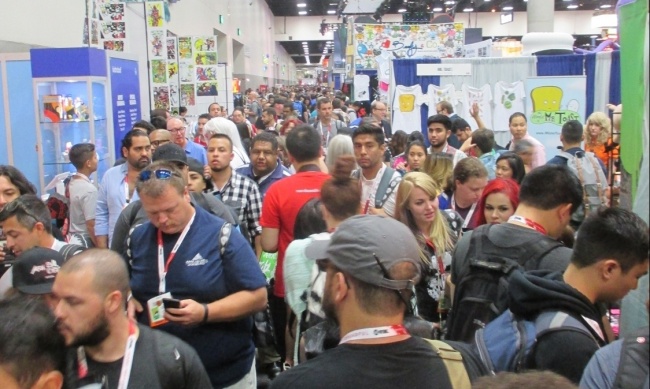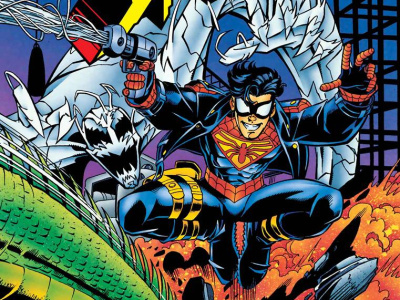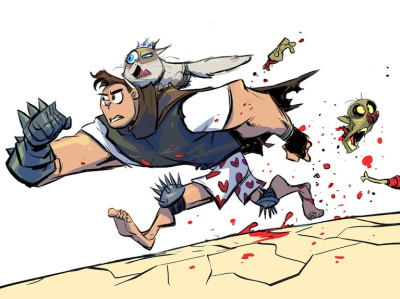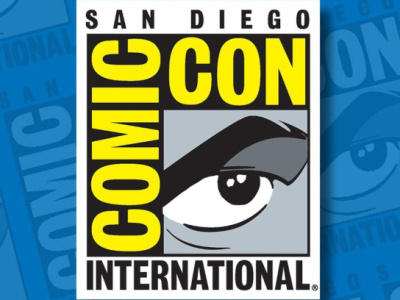This weekend, New York ComicCon marks the traditional conclusion to the convention season, though there will still be plenty of shows to keep fans warm during the winter months. But it’s a good time to take stock of a few trends that made themselves felt as the fan events industry becomes more deeply ingrained in the economy and culture.
Consolidation at the top end. Comic conventions emerged from the do-it-yourself fan culture, at a time when few events companies deigned to notice the rabble of collectors and cosplayers who turned up for the weekend at the local hotel ballroom. Even a few years ago, it was possible for non-professionals to put together a convention that would end up drawing 20, 30, 40,000 attendees or more. 2015 served notice that those days are coming to an end, at least as far as the big mainstream conventions go.
This year’s season began with the announcement that ReedPop had acquired Seattle’s Emerald City ComicCon, one of the templates for how an independent regional show could grow organically into a major event. It ends with last week’s news that Washington’s AwesomeCon, a three-year old independent show that quickly earned a reputation as a premier fan confab, had sold to LeftField Media, a new event company founded by former Reed executive Greg Topalian (see “LeftField Media Acquires Awesome Con”).
There are still a few big indie shows out there, but the biggest (Denver ComicCon and, of course, Comic-Con International: San Diego) have the distinct advantage of being organized as non-profits, which means they do not have to answer to a corporate board of directors or maximize their commercial advantage at the expense of their mission. It seems very hard to picture any mainstream-oriented for-profit show, even one closely held by organizers, long resisting the dollars that major companies could dangle in front of them if the fan events market heats up into a competitive feeding frenzy.
Specialization at the bottom end. One benefit of a booming market is that you can have growth in multiple dimensions simultaneously. If your tastes run to smaller, more indie-minded shows, the success of the first CXC festival in Columbus this past weekend, along with a lot of enthusiastic reports from SPX, TCAF, the Brooklyn Book Festival, and APE, indicates that the festival scene is thriving. These shows tend to rely more on the support of institutional sponsors than the traditional Con economy of exhibitors, stiff ticket prices and commercial partners, so positive reports and good attendance may keep them viable.
Another trend is the emergence of “traditional” fan and collectors shows catering specifically to older fans burned out by the cosplay and celebrity culture of modern “everything” conventions. ReedPop’s Special Edition: NYC taps into this market, as does the San Diego Comic Fest coming up in February. If shows like these can become firmly established in their niches, it would go a long way toward addressing the concerns of certain kinds of exhibitors who are no longer as relevant to the audiences at bigger mainstream conventions.
Globalization. Two of the largest comics shows in the world take place outside the US: The Festival Internationale de la Bande Desinee in Anguleme, France, and Tokyo’s Comiket, and there have been a bunch of successful events launched internationally in recent years. This is starting to really heat up as ReedPop in particular has set its sights on huge global markets such as India, China, Brazil and the Middle East.
Later this month we will see a very interesting proof of concept when ReedPop debuts its American-style Paris Comic Con in the very heart of Europe’s biggest market for graphic literature. Billed as a Festival of Pop Culture, Paris Comic Con is sure to spark excitement and controversy in a culture that is jealously protective of its prerogatives and deeply suspicious of American corporate expansionism.
Diversification. I’ve belabored the changing demographics of the convention audience at length here, but it bears repeating. Today’s fan cons are trending younger and more female, with women expressing the greatest enthusiasm for fantasy/sci-fi, comics-related media and manga/anime, compared to persistent male majorities in comics and gaming.
One important thing that this research revealed is that female fans do not differ from men in the intensity of their fandom (roughly similar numbers describe themselves as “super-fans” and have diverse fan interests), the frequency of attendance (women actually go to slightly more ticketed fan events per year than men), or their spending (women tend to spend at the median level of $250-$500, whereas guys either spend a lot or a little). The only area where women differ significantly from male fans is in their affinity for cosplay.
The time for denying the obvious is long past. I would not be surprised to see women as the clear majority among attendees in the next 2-3 years.
Technology. The last trend to watch is the growing convergence between in-person, real-time events in the physical world and new location-based, data-driven technology. I’ve been working with a company called Artifact Technologies, which has been deploying a very cool location-based mobile game called Battlekasters at conventions this past season. Another company is developing beacon-based navigation to help fans find what they’re looking for faster in crowded cons.
Those are just a couple of interesting initiatives to add a new digital dimension to the convention experience. For organizers and venues, the challenge is to ensure connectivity keeps up with demand. Wi-Fi access was the top of the list of attendee complains in the Eventbrite survey this year. Once we can count on a strong signal, expect a flood of innovations, from the useful to the bizarre, coming soon to a Convention App near you.
Programming note. If you are interested in the future of conventions, please join me at NYCC on Saturday, 6:30 in room 1B03, for a panel called “Taking Fan Conventions to the Next Level.” I’m scheduled to be joined by ReedPop’s Jim Demonakos (founder of ECCC) and Artifact’s Brent Friedman, in a conversation moderated by The Beat herself, Heidi MacDonald.
--Rob Salkowitz (@robsalk) is the author of Comic-Con and the Business of Pop Culture.
The opinions expressed in this column are solely those of the writer, and do not necessarily reflect the views of the editorial staff of ICv2.com.

Column by Rob Salkowitz
Posted by Rob Salkowitz on October 5, 2015 @ 5:07 pm CT
MORE COMICS
Part of 1996 Marvel/DC Crossover
August 1, 2025
Writer Karl Kesel and artist Mike Wieringo are the creative team for the one-shot comic, which was first published in 1996 in the middle of a Marvel/DC crossover.
Crowdfunding Campaign Launches in October, Followed by Retail Release
August 1, 2025
Vault will crowdfund the graphic novel on the Backerkit platform in October, then release it to retail.
MORE COLUMNS
Column by Scott Thorne
July 28, 2025
This week, columnist Scott Thorne comments on the Edge of Eternities prerelease and on Magic: The Gathering news from the Hasbro earnings report.
Column by Rob Salkowitz
July 21, 2025
Columnist Rob Salkowitz lays out the Comic-Con panels of interest to industry professionals, current and aspiring creatives, educators, librarians and retailers.








